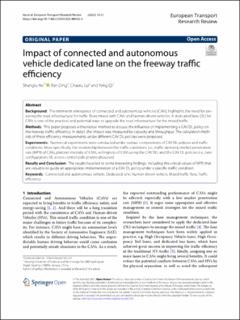| dc.contributor.author | He, Shanglu | |
| dc.contributor.author | Ding, Fan | |
| dc.contributor.author | Lu, Chaoru | |
| dc.contributor.author | Qi, Yong | |
| dc.date.accessioned | 2023-02-10T10:22:16Z | |
| dc.date.available | 2023-02-10T10:22:16Z | |
| dc.date.created | 2022-04-19T14:03:17Z | |
| dc.date.issued | 2022-04-04 | |
| dc.identifier.issn | 1867-0717 | |
| dc.identifier.issn | 1866-8887 | |
| dc.identifier.uri | https://hdl.handle.net/11250/3049988 | |
| dc.description.abstract | Background: The imminent emergence of connected and autonomous vehicles (CAVs) highlights the need for preparing the road infrastructure for traffic flows mixed with CAVs and human-driven vehicles. A dedicated lane (DL) for CAVs is one of the practical and potential ways to upgrade the road infrastructure for the mixed traffic.
Methods: This paper proposes a theoretical method to discuss the influence of implementing a CAV DL policy on the freeway traffic efficiency. In detail, the impact was measured by capacity and throughput. The calculation methods of these efficiency measurements under different CAV DL policies were proposed.
Experiments: Numerical experiments were conducted under various compositions of CAV DL policies and traffic conditions. More specifically, the relationship between the traffic conditions (i.e., traffic demand, market penetration rate (MPR) of CAVs, platoon intensity of CAVs, willingness of CAVs using the CAV DL) and the CAV DL policies (i.e., lane configuration, DL access control policy) were discussed.
Results and Conclusion: The results have led to some interesting findings, including the critical values of MPR that are valuable to guide an appropriate implementation of a CAV DL policy under a specific traffic condition. | en_US |
| dc.language.iso | eng | en_US |
| dc.publisher | SpringerOpen | en_US |
| dc.relation.ispartofseries | European Transport Research Review;14, Article number: 12 (2022) | |
| dc.rights | Navngivelse 4.0 Internasjonal | * |
| dc.rights.uri | http://creativecommons.org/licenses/by/4.0/deed.no | * |
| dc.subject | Connected and autonomous vehicles | en_US |
| dc.subject | Dedicated lanes | en_US |
| dc.subject | Human-driven vehicles | en_US |
| dc.subject | Mixed traffic flows | en_US |
| dc.subject | Traffic efficiency | en_US |
| dc.title | Impact of connected and autonomous vehicle dedicated lane on the freeway traffic efficiency | en_US |
| dc.type | Peer reviewed | en_US |
| dc.type | Journal article | en_US |
| dc.description.version | publishedVersion | en_US |
| dc.rights.holder | © The Author(s) 2022 | en_US |
| dc.source.articlenumber | 12 | en_US |
| cristin.ispublished | true | |
| cristin.fulltext | original | |
| cristin.qualitycode | 1 | |
| dc.identifier.doi | https://doi.org/10.1186/s12544-022-00535-4 | |
| dc.identifier.cristin | 2017592 | |
| dc.source.journal | European Transport Research Review | en_US |
| dc.source.volume | 14 | en_US |
| dc.source.issue | 14 | en_US |
| dc.source.pagenumber | 1-14 | en_US |
| dc.relation.project | National Key Research and Development Program of China: 2019YFE0123800 | en_US |
| dc.relation.project | National Natural Science Foundation of China: 52102380 | en_US |
| dc.relation.project | China Postdoctoral Science Foundation: 2021T140325 | en_US |
| dc.relation.project | China Postdoctoral Science Foundation: 2018M642257 | en_US |
| dc.relation.project | National Social Science Fund of China: 18CFX062 | en_US |
| dc.relation.project | Fundamental Research Funds for the Central Universities: 330920021140 | en_US |
| dc.relation.project | National Natural Science Foundation of China: 71971116 | en_US |
| dc.relation.project | 2019 major science and technology project of CCCC: 2019-ZJKJ-ZDZX02 | en_US |

